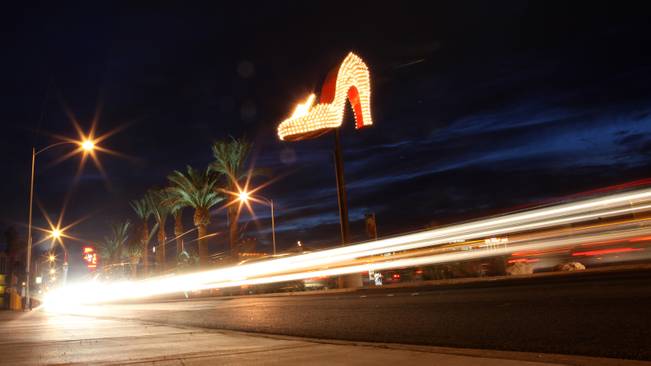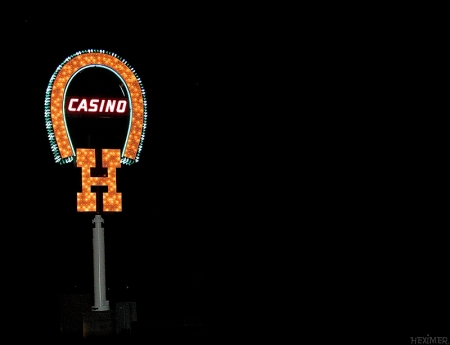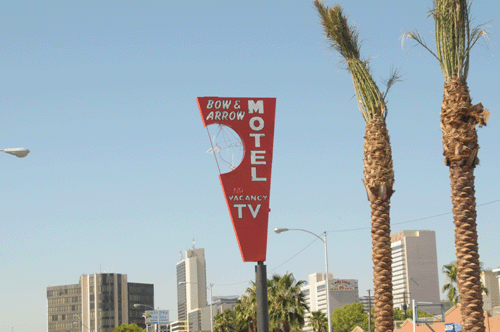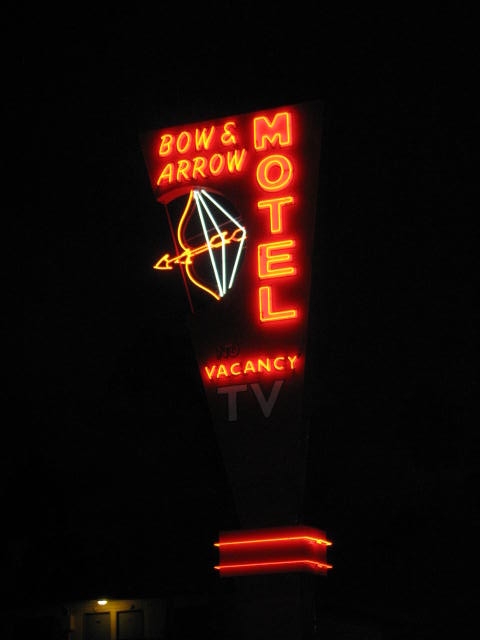The City of Las Vegas, working with the Neon Museum, has installed three neon signs from the Neon Boneyard. Better yet, on Monday evening, the City held a relighting ceremony as the Bow and Arrow Motel, the Horseshoe "H" and the beloved Silver Slipper were turned back on.

From the Las Vegas Sun:
At first glance, drivers might wonder if there's a giant ladies' footwear sale going on near Cashman Stadium.
But no. That giant sparkling high-heeled shoe perched near the tops of the palm trees along Las Vegas Boulevard North is actually a step back into the city's neon past.
Shimmering with some 980 twinkling lights, the shoe was originally the whimsical icon of the Silver Slipper Gambling Hall that had its heyday nearly a half century ago.
But now the restored 12-by-17-foot three-dimensional shoe is a symbol of the city's commitment to step up to honor its colorful historical main drag.
The Silver Slipper, which also glitters with stories about billionaire recluse Howard Hughes and even "Mr. Las Vegas" Wayne Newton, was one of three historic neon signs turned on at dusk Monday along Las Vegas Boulevard.
With a countdown led by Mayor Oscar Goodman, the three signs were lighted during a ceremony at the Reed Whipple Cultural Center.
"It was 90 years ago, in 1929, that we had the first neon here in Las Vegas turned on," Goodman said. "... We have a unique city, with a unique art form. We preserved it and we're going to continue to preserve it."
The three signs, on loan from the Neon Museum, were lit to celebrate the designation of Las Vegas Boulevard as a National Scenic Byway from Washington Avenue to the north to Sahara Avenue to the south.
"Specifically, in an economy where things are going down, ladies and gentlemen, we continue to bring lights up in the entertainment capital of the world," said Ward 5 Councilman Ricki Barlow.
The designation, granted in October, will help the city to get federal funds to restore as many as 20 historic neon signs in the median in that corridor, Goodman said.

"The city council has made a decision that we're not going to implode our history. We're going to preserve our history," Goodman said.
"That's why we have the Neon Museum across the street, the Neon Boneyard. And now we're beginning to exhibit these things that make us really distinct from any other city. It's a lot of fun, number one. And number two, it has great significance because this is what we're all about. This is where we came from."
He said the city will use Las Vegas Boulevard's new scenic byway as a canvas for painting the city's history with its local art form, neon signs.
"This is our history," he said. "We're unique here in Las Vegas. ... No other place has the kind of art form that we have. I think it's very important when people go up and down this particular road that they're able to share our history with us and enjoy these very iconic locations."
Among dignitaries attending the ceremony was U.S. Rep. Shelley Berkley, D-Nev., who remembered one of the first things she saw upon coming to Las Vegas as a child were the glittering signs.
"I remember through 12-year-old eyes, driving down the Strip for the first time and seeing this extraordinary street with this magnificent neon," she said. "I remember thinking when I was 12 years old this is the most remarkable street I have ever seen. Forty-seven years later I drive down the same street, I have the same reaction and it takes my breath away."
A cultural corridor
City Manager Betsy Fretwell said the highest concentration of cultural institutions in Las Vegas was in the vicinity of the signs, including Cashman Center, the Las Vegas Library, the Natural History Museum, the Lied Discovery Children's Museum, the Neon Museum, the Old Las Vegas Mormon Fort, the State Historic Park and the Reed Whipple Cultural Center.
The first three vintage signed were refurbished and installed in new landscaped median islands for $1.1 million.
About a block to the south of the glittering slipper is the original sign for the Bow & Arrow Motel. At 35-feet tall and six-feet wide, it lights up the median near Bonanza Street with bright red lettering and an animated arrow being strung onto a bow.
The sign was the beacon for the motel that originally located in the downtown on Las Vegas Boulevard at Wyoming Avenue during the late 1950s or early 60s.
To the north, in the median that splits the street into a byway, is another sign that once glittered at Binion's Horseshoe Casino on Fremont Street. The sign was built by Young Electric Sign Company and installed in the 1960s.
The 13-by-12-foot rotating sign features a large golden neon horseshoe trimmed in blue neon lights, with an "H" at the bottom in gold flashing neon and red "CASINO" in the center.
"That's as important as any sign in the community," Goodman said. "When Benny Binion opened the Horseshoe, we established our reputation as being able to take a bet on anything and no limit. And that's what Las Vegas is all about.
Tales of the Silver Slipper
Before the ceremony, William Marion, who chairs the Neon Museum Board, told a story about Howard Hughes' and Wayne Newton's involvement with the Silver Slipper sign.
Hughes, who had moved to the Desert Inn in late 1968 and eventually bought it, had a penthouse directly across the street from the Silver Slipper sign, which was brightly lit and rotated. Hughes made a request that it be turned off.
"They wouldn't shut it off, so he told his aides to buy the property," Marion said. "That's how he got to own the Silver Slipper."
There were other rumors, too, about why Hughes bought the Silver Slipper, including he thought someone had put a camera in its toe that was pointed at his penthouse and spying on him.
Wayne Newton's involvement with the Silver Slipper sign came after Hughes had the sign taken down.
Newton had come to the sign's resting place, in the city's Neon Boneyard, to do promotional shoot years later. And when the 6-foot-3, barrel-chested singer stepped up on its toe, his foot went through it, Marion said.
Colorful characters
Goodman said he used to spend a lot of time over at the Silver Slipper, which he called "one of the original joints, so to speak."
"It had a lot of colorful people who used to hang out there at that part of the Strip," he said.
Goodman, known for his love of martinis, chuckled at the thought of how much of his favorite gin that particular Silver Slipper sign might hold. No, the mayor said. He hadn't done the math.
"Now that you mention it, it takes on a very special significance," he said, chuckling.


Thanks also to Jack LeVine at VeryVintageVegas.com for allowing us to use some of these images